Text
Tapinocaninus

Tapinocaninus was a genus of tapinocephalid therapsid from the Middle Permian. Its type and only species is T. pamelae. Its known specimens were found in the Karoo Supergroup in South Africa. Tapinocaninus is the largest known therapsid from the Guadalupian Period.
The generic name Tapinocaninus means humble (tapino) canine (caninus). The specific name pamelae was named for Pam Rubridge, the mother of the original describer, Bruce S. Rubridge. She was on the field when he discovered the first fossils.
Most known Tapinocaninus fossils consist of skulls, though its spine of 36 vertebrae, several ribs, pectoral and pelvic girdles, three humeri, and a femur have been discovered. Its autapomorphies include a relatively large temporal opening, only having two sacral vertebrae, only seven caudal vertebrae, a notably high amount of vertebral intercentra, an anterior coracoid included in the glenoid, which is straight and facing posteroventrally, and the lack of ectepicondylar foramen.
Tapinocaninus has been recovered as the most basal member of Tapinocephalidae, as it has both derived dinocephalian features and ancestral features of sphenacodonts. Tapinocephalidae itself is the most derived family of Dinocephalia.
Original paper: Rubridge 1991, Postcranial materials description 2019
Wikipedia article: here
#tapinocaninus#tapinocanininae#tapinocephalidae#dinocephalia#therapsida#therapsids#paleoart#paleontology#original art#human artist#artwork#obscure fossil animals#obscure fossil therapsids
8 notes
·
View notes
Text
Iberica hahni

Iberica was a genus of multituberculate mammal from the Early Cretaceous Period. Its type and only species is I. hahni. Known specimens were found in the El Castellar Formation in Galve, Spain. While the fossils assigned to Iberica have been known since the 1960s, they were not officially named until 2011.
The name Iberica comes from the fossil's location on the Iberian Peninsula. The specific name hahni was named in honor of Gerhard and Renate Hahn for their research on Iberian Peninsula multituberculates.
Known fossils of I. hahni include seven P1/3s (premolars), which are the type specimen, as well as the referred material of a P4 fragment (premolar) and two M2s (molars). Its autapomorphies include the four cusps on its premolars, as compared to three cusps from related genera, as well as cuspules on the mesial and distal margins.
The material assigned to I. hahni, especially the referred P4 and M2s, cannot be certainly assigned to either Eobaataridae or Plagiaulacidae. The type premolars are similar to that of Parabolodon elongatus and Eobaatar? pajaronensis. The P4 fragment is also very similar to that of Cheruscodon balvensis. The tentative assignment to Eobaataridae seems somewhat unlikely.
References: Original description by Ainara Badiola, José Ignacio Canudo, and Gloria Cuenca-Bescós; cladistic assessment by Thomas Martin et al.
Wikipedia article: Iberica hahni
#mammal#mammalia#paleoart#paleontology#artwork#original art#human artist#iberica#eobaataridae#plagiaulacidae#plagiaulacida#multituberculata#obscure fossil animals#obscure fossil mammals
15 notes
·
View notes
Note
If you want a really, really obscure genus to draw how about Portezueloemys? It's a genus of turtle that doesn't even have a wikipedia page.
looks neat ! another one to add to the reptile (and article-less) pile :)
0 notes
Text
art updated for accuracy :)
Talenkauen santacrucensis
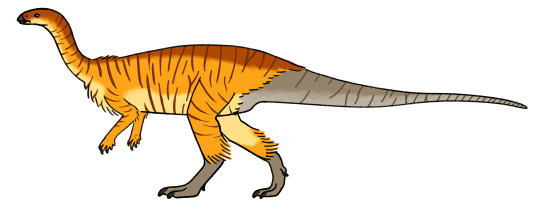
Talenkauen was a genus of neornithischian dinosaur from the Late Cretaceous period. Its type species is T. santacrucensis. The only specimen was found on Los Hornos Hill on the coast of Viedma Lake in Patagonia, Argentina. This specimen was found lying next to a scattering of fragmentary bones and teeth, which has been identified as a recently-hatched baby T. santacrucensis.
Talenkauen means "small skull;" its root words "talenk" and "kauen" originate from the Aonikenk language.
Its autapomorphies include a well–developed epipophysis on cervical 3 and plate–like unicate processes on the rib cage.
Talenkauen was a bipedal herbivorous dinosaur. It was at most 4 meters long, with a similar build to Dryosaurus, having short limbs, a long trunk and neck, and a small head. It was found to be closely related to Macrogryphosaurus and the clade Elasmaria was erected for the two genera. As of 2019, Elasmaria now includes almost a dozen genera.
Original paper: Novas, Fernando E.; Cambiaso, Andrea V; Ambrioso, Alfredo (2004). "A new basal iguanodontian (Dinosauria, Ornithischia) from the Upper Cretaceous of Patagonia". Ameghiniana. 41 (1): 75–82.
Wikipedia article: https://en.m.wikipedia.org/wiki/Talenkauen
20 notes
·
View notes
Text
art updated for accuracy :)
Isasicursor santacrucensis
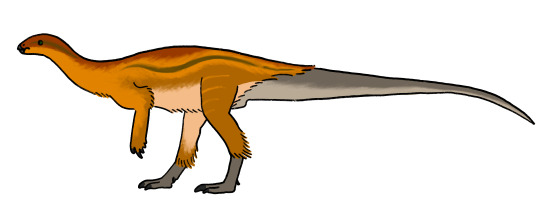
Isasicursor was a genus of neornithischian dinosaur from the Late Cretaceous period. Its type species is I. santacrucensis. The first specimen was found in the Chorillo Formation in Patagonia, Argentina in 2019. About 16 other specimens were referred to the genus, representing at least 4 individuals.
Isasicursor means "Isasi's runner," referring to Marcelo P. Isasi, the species' discoverer.
Its autapomorphies include a ventrally curved sacrum, peg-and-socket articulation between the first and second sacral vertebrae, the tibia's cnemial crest is proximally projected and thickened, the tibia has an additional anterolateral process on the lateral condyle, and metatarsal II has a proximally displaced indent for a ligament on its lateral surface.
Isasicursor was a bipedal herbivorous dinosaur. It would have been around 4 meters long. While there have been no further cladistic analyses performed, it was initially placed in Elasmaria, which, if correct, would make it the youngest known ornithopod from South America.
Original paper: Novas, F., Agnolin, F., Rozadilla, S., Aranciaga-Rolando, A., Brissón-Eli, F., Motta, M., Cerroni, M., Ezcurra, M., Martinelli, A., D'Angelo, J., Álvarez-Herrera, G., Gentil, A., Bogan, S., Chimento, N., García-Marsà, J., Lo Coco, G., Miquel, S., Brito, F., Vera, E., Loinaze, V., Fernandez, M., & Salgado, L. (2019). Paleontological discoveries in the Chorrillo Formation (upper Campanian-lower Maastrichtian, Upper Cretaceous), Santa Cruz Province, Patagonia, Argentina. Revista del Museo Argentino de Ciencias Naturales, 21(2), 217-293.
Wikipedia article: https://en.m.wikipedia.org/wiki/Isasicursor
Tags: #dinosaur #dinosauria #paleoart#paleontology#artwork#original art#human artist#[genus] #[family/clade] #[family/clade] #[family/clade] #obscure fossil animals
10 notes
·
View notes
Text
art updated for accuracy :)
Notohypsilodon comodorensis

Notohypsilodon was a genus of neornithiscian dinosaur from the Late Cretaceous period. Its type species is N. comodorensis. The only specimen was found in the Bajo Barreal Formation in Chubut, Patagonia in 1985. The specimen in question has been identified as a juvenile due to the fact its neural arches are not fused to the body of the vertebrae.
Its autapomorphies include the femur's lateral margin of the greater trochanter is sigmoidal in shape, with a thick posterior edge and a very thin anterior edge, as well as, the proximal end of metatarsal IV has a thick and very well-developed posterior process that medially wraps metatarsal III.
The holotype consists of four neck, seven back, five hip, and six tail vertebrae, four rib fragments, a partial right coracoid, a partial left scapula, a right humerus, both ulnae, a right fibula and astragalus, a left femur, tibia, fibula, partial astragalus, and calcaneum; and thirteen phalanges.
Notohypsilodon was a small bipedal herbivore. It would most likely have been around 1-2 meters long. It was originally classified as a hypsilodont, hence its name, but was later found to be too fragmentary to be classified past Euornithopoda. A study in 2015 classified it as part of Elasmaria, a basal ornithischian clade.
Original paper: Martínez, Rubén D. (1998). "Notohypsilophodon comodorensis, gen. et sp. nov., un Hypsilophodontidae (Ornithischia: Ornithopoda) del Cretacico Superior de Chubut, Patagonia central, Argentina". Acta Geologica Leopoldensia (in Spanish and English). 21 (46/47): 119–135.
Wikipedia article: https://en.m.wikipedia.org/wiki/Notohypsilophodon
9 notes
·
View notes
Text
art has been updated for accuracy :)
Changchunsaurus parvus

Changchunsaurus was a genus of neornithischian dinosaur from the Cretaceous period. Its type species is Changchunsaurus parvus. The only specimen was found in the Quantou Formation of the Songliao Basin in 2005. It is the first dinosaur found in the Jilin province of China.
Its autapomorphies include a slit-like incisive foramen present on the midline of the premaxillary palate, medial to crowns three and four, with foramen positioned lateral to it on each side; a thickened and slightly rugose dorsolateral surface of the dentary, continuous to the predentary; and a groove extending rostromedially along the lateral surface of the caudal half of the dentary and onto the medial surface of the coronoid process.
It is not exactly known where Changchunsaurus sits amongst other neornithischians, but it has been found to be closely related to Jeholosaurus and Haya. It is known from the holotype that includes the skull, the axial column as far as the cranial end of the sacrum, and partial forelimbs and hind limbs. Only the skull is described in its original paper. It may also be known from additional material found in the Quantou Formation, some of which was described and referred to the genus in 2010.
Original paper: Zan Shu-Qin; Chen Jun; Jin Li-Yong; Li Tao (2005). "A primitive ornithopod from the Early Cretaceous Quantou Formation of Central Jilin, China". Vertebrata PalAsiatica (in Chinese and English). 43 (3): 182–193.
Referred specimen paper: Jin Liyong; Chen Jun; Zan Shu-Qin; Richard J. Butler & Pascal Godefroit (2010). "Cranial anatomy of the small ornithischian dinosaur Changchunsaurus parvus from the Quantou Formation (Cretaceous: Aptian–Cenomanian) of Jilin Province, northeastern China". Journal of Vertebrate Paleontology. 30 (1): 196–214. doi:10.1080/02724630903412372
Wikipedia article: https://en.m.wikipedia.org/wiki/Changchunsaurus
29 notes
·
View notes
Text
art has been updated for accuracy :)
Nevadadromeus schimtti

Nevadadromeus was a genus of neornithischian dinosaur from the Late Cretaceous period. Its type species is Nevadadromeus schmitti. The only specimen was found near the Valley of Fire in the Willow Tank Formation in the U.S. state of Nevada in 2008. It represents both the first non-avian dinosaur and the first unique dinosaur known from Nevada.
The specimen was not described or named until 2022, in which it was assigned to Thescelosaurinae. Nevadadromeus is known from fragmentary remains including the proximal femora, several vertebrae without neural arches, ossified tendon fragments, several pedal phalanges, and some other unidentifiable remains.
Original paper: Bonde, Joshua W.; Hall, Rebecca L.; Krumenacker, L. J.; Varricchio, David J. (2022). "Nevadadromeus schmitti (gen. et sp. nov.), a New Basal Neornithischian with Affinities to the Thescelosaurinae, from the Upper Cretaceous (Cenomanian) Willow Tank Formation of Southern Nevada". Journal of the Arizona-Nevada Academy of Science. 50 (1): 1–8. doi:10.2181/036.050.0101. ISSN 0193-8509. S2CID 252931645.
Wikipedia article: https://en.m.wikipedia.org/wiki/Nevadadromeus
7 notes
·
View notes
Text
art has been updated for accuracy :)
Yueosaurus tiantaiensis

Yueosaurus was a genus of neornithiscian dinosaur from the Cretaceous period. Its type species is Y. tiantaiensis. The only specimen was found in the Liangtoutang Formation. It represents the first known basal neornithopod dinosaur from China, and the southernmost known from Asia as a whole.
Its autapomorphies include anteroventral expansion of the scapula that exceeds its posteroventral expansion, the scapula's posterior edge that is almost perpendicular to the shaft, the scapula has a ventroscapular groove, and the scapula also possesses both a supraglenoidal buttress and supraglenoid fossa.
Due to its fragmentary nature, it is impossible to carry out detailed phylogenic analysis. However, it is identifiable as a neornithischian dinosaur, most likely closely related to Jeholosauridae or Thescelosauridae due to its more basal features. Y. tiantaiensis is known from cervical, dorsal, and caudal vertebrae; scapula, rib, hip bones, and partial forelimb and hindlimb fossils.
Original paper: Zheng, Wenjie; Xingsheng Jin; Masateru Shibata; Yoichi Azuma; Fangming Yu (2012). "A new ornithischian dinosaur from the Cretaceous Liangtoutang Formation of Tiantai, Zhejiang Province, China". Cretaceous Research. 34: 208–219. doi:10.1016/j.cretres.2011.11.001.
Wikipedia article: https://en.m.wikipedia.org/wiki/Yueosaurus
30 notes
·
View notes
Text
art has been updated for accuracy :)
Yandusaurus hongheensis

Yandusaurus was a genus of ornithischian dinosaur from the Middle Jurassic. Its type species is Y. hongheensis. The only specimen was found in Jinzidang near the Honghe dam during construction in 1973. The fossil had been accidentally processed partially through the composter but was still intact enough to work with, and it was formally described in 1979.
A second species, Y. multidens, was named in 1983, but this was later reassigned to Agilisaurus in 1992 and then Othnielia (Nanosaurus) in 1996. Eventually, in 2005, it was described as its own genus as Hexinlusaurus multidens.
The fossil consists of the skull, vertebral column, shoulder girdle, frontlimbs and hindlimb, all of which are heavily damaged. The end of the tail, lower jaws, and pelvis were most likely destroyed in the composter. Y. honheensis was bipedal and likely a fast runner with four toes on its hind legs and five on its front legs. It had large eyes and its teeth showed unique patterns of parallel ridges along them.
Original paper: He, X. "A newly discovered ornithopod dinosaur-Yandusaurus from Zigong, China." Contributions to International Exchange of Geology, Part 2 (1979): 116-123.
Wikipedia article: https://en.m.wikipedia.org/wiki/Yandusaurus
88 notes
·
View notes
Text
art has been updated for accuracy :)
Sanxiasaurus modaoxiensis

Sanxiasaurus was a genus of neornithischian dinosaur from the Middle Jurassic. The only specimen was found in the Xintiangou Formation of Yunyang, Chongqing Municipality, China. It is the oldest known neornithischian from Asia.
Its autapomorphies include at least four sacrals, a laterally bowed humerus, an obturator process located midway on the ischial shaft, a broadened and wing-shaped lesser trochanter of the femur, which is also subequal in anteroposterior width to the greater trochanter; and a distal tibia with elongate posterolateral process.
It is more basal than Lesothosaurus, but more derived than Hexinlusaurus. The holotype fossil consists of 55 postcranial bones, including vertebrae, both humeri, radii, and ulnas, and several leg bones.
Original paper: Ning Li, Hui Dai, Chao Tan, Xufeng Hu, Zhaoying Wei, Yu Lin, Guangbiao Wei, Deliang Li, Li Meng, Baoqiao Hao, Hailu You & Guangzhao Peng (2021) A neornithischian dinosaur from the Middle Jurassic Xintiangou Formation of Yunyang, Chongqing, China: the earliest record in Asia, Historical Biology, 33:7, 1089-1102, DOI: 10.1080/08912963.2019.1679129
Wikipedia article: https://en.m.wikipedia.org/wiki/Sanxiasaurus
6 notes
·
View notes
Text
Sulestes

Sulestes was a genus of deltatheroidean mammal from the Cretaceous Period. Its type species is S. karakshi. The known specimens were found in the Bissekty Formation, Kyzyl Kum desert, Uzbekistan. Sulestes was the first and currently only identified metatherian taxon from the Bissekty Formation.
Its autapomorphies include the first premolar's oblique orientation relative to the dentary, an asymmetrical third molar, the presence of a fourth non-vestigial molar, and a double-rooted first premolar.
Sulestes is known from its holotype, a left maxilla fragment, as well as referred specimens. These specimens were originally labelled under "Deltatherus" and "Marsasia" and consist of a right petrosal, right maxilla, two left maxilla fragments, left coronoid process, several right and left dentary fragments, and a few isolated teeth. Sulestes is recovered as the sister taxon to Deltatheroides and Deltatheridium within Deltatheroida.
Citations: The original description paper, Nessov 1983, is not available online. Nessov and Russell 1994 (description); Averianov, Archibald, and Ekdale 2010 (referred material).
Wikipedia article: here
#mammal#mammalia#paleoart#paleontology#artwork#original art#human artist#sulestes#deltatheroida#metatheria#theria#obscure fossil animals#obscure fossil mammals#obscure fossil tetrapods
12 notes
·
View notes
Note
How about Matuku otagoense/the Saint Bathans heron? I haven't seen a single reconstruction of it apart from one I did myself a while back.
ooh looks really neat, ill add it to the list! thank u !!!
0 notes
Text
Siamraptor

Siamraptor was a genus of carcharodontosaurian dinosaur from the Early Cretaceous period. Its type species is S. suwati. The holotype was found in the Khok Kruat Formation in northeastern Thailand. Siamraptor is the first and currently only definite carcharodontosaurian known from Southeast Asia.
"Siam" is derived from the original name of Thailand, "raptor" is Latin for robber, and the specific name suwati refers to Suwat Liptapanlop, a supporter of the Northeastern Research Institute of Petrified Wood and Mineral Resources.
Its autapomorphies include a jugal with a straight ventral margin and a deep anterior process below the orbit, a surangular with a concavity and four posterior foramina, a groove along the suture between the surangular and prearticular, an articular with a formen at the suture with the prearticular, a cervical vertebra with an additional foramen that is excavating the parapophysis, and the presence of a pair of foramina at the base of the neural spine on the cervical and posterior dorsal vertebrae. Another possible autapomorphy specific to the genus may be a deep concavity excavating the posterior end of the lateral shelf.
Siamraptor is known from its holotype, consisting of a posterior right mandible including the surangular, prearticular, and articular; as well as referred material from three other individuals including three right premaxillae, a right and left maxillae, a left jugal, two posterior parts of the left mandible, three cervical vertebrae, a caudal vertebra, a manual ungual, a right ischium, a section of the left tibia, and a left pedal phalanx. Siamraptor was recovered as a definite carcharodontosaurian, though its relationships within the clade are uncertain. It may have been a derived member of Allosauria outside of Allosauridae or a basal member of Carcharosauria in a polytomy with Eocarcharia, Concavenator, and Neovenator.
Original paper: Original description paper
Wikipedia article: here
#dinosaur#dinosauria#paleoart#paleontology#artowkr#original art#human artist#siamraptor#carcharodontosauria#allosauria#carnosauria#tetanurae#theropoda#saurischia#obscure fossil animals#obscure fossil dinosaurs#obscure fossil tetrapods
12 notes
·
View notes
Text
Kraglievichia
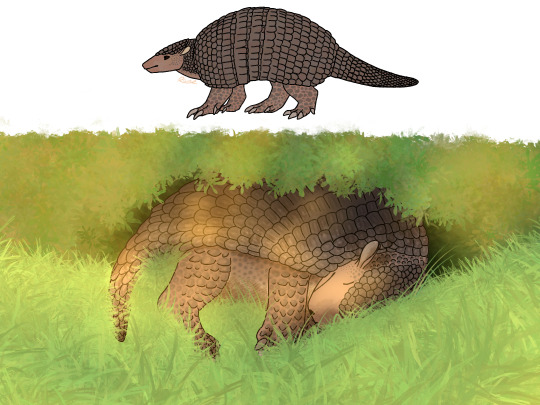
Kraglievichia was a genus of cingulate mammal from the Late Miocene to Early Pliocene periods. Its type species is K. paranense. Its second known species is K. carinatum. The known specimens were found in Argentina and Uruguay. Though initially described in 1883, Kraglievichia was not properly named until 1927.
Its autapomorphy from similar relatives is its distinct osteoderm ornamentation, which consists of significantly deep longitudinal depressions with a longitudinal central elevation. It is the most conspicuously ornamented pampatheriid known currently.
The known specimens of Kraglievichia consist of osteoderms, a left femur, and a well-preserved skull without any teeth. Due to their extreme similarity, Kraglievichia is regarded as the sister taxon to Scirrotherium, the genus that K. carinatum was originally assigned to. It was hypothesized that Holmesina evolved from Kraglievichia, but due to the fact there are no known immediate South American basal forms of Holmesina, this is unlikely. A third species, "K." floridanus, was named in 1976, but this was later found to be a species of Holmesina instead.
Citations: The 1927 description seems entirely lost, at least online; if you happen to have access to this paper please let me know. 1883 description (page 66 of pdf) as Chlamydotherium; "Scirrotherium" carinatum description; "S." carinatum reassignment.
Wikipedia article: here
#mammal#mammalia#paleoart#paleontology#artwork#original art#human artist#kraglievichia#pampatheriidae#cingulata#xenarthra#obscure fossil animals#obscure fossil mammals#obscure fossil tetrapods
11 notes
·
View notes
Text
Milosaurus mccordi
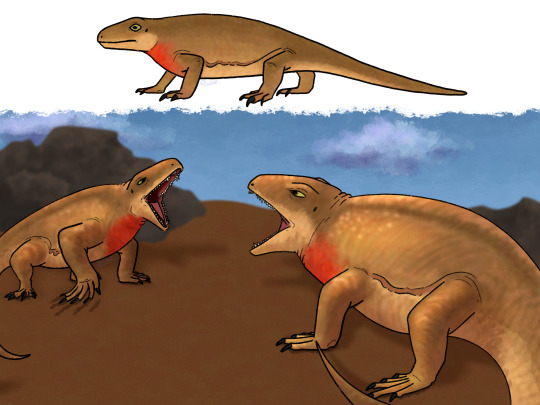
Milosaurus was a genus of haptodontiform synapsid from the Late Carboniferous Period. Its type species is M. mccordi. Its known specimens were found in Jasper County, Illinois, USA. Milosaurus is one of the first amniotes to have a body mass above 20kg and is incredibly important in understanding the evolution of early synapsids.
Milosaurus mccordi is named for Mr. Milo Flynn and Mr. Chester McCord on whose property the fossils were found.
Its autapomorphies include mainly the odd morphology of the femur, which consists of an anteroposteriorly broad and slightly flattened anterior condyle, a uniquely cylindrical posterior condyle with a flattened distal surface, and an unusually prominent internal trochanter. Its fifth metatarsal also has a broad proximal end.
Milosaurus is known from its holotype and nearby referred fossils which consist of a pelvis, hind limb and pes, many caudual vertebrae, a lumbar vertebra, a lumbar or caudal neural spine, a presacral rib (which may actually be a femur), and a small chunk of maxilla containing two teeth. Originally, the advanced features of its skeleton placed it certainly within Sphenacodontia, but its retention of primitive features placed it more basal than Varanops. A more recent cladistic analysis from 2018 places it within Haptodontiformes, outside of Varanopsidae. The additional referred teeth, dorsal rib (femur), dorsal vertebrae, and neural arch are argued to not necessarily represent a member of Milosaurus due to additional pelycosaur discoveries in the area and are not included in the analysis.
Citation: Original description paper, Re-examination of the taxon
Wikipedia article: https://en.wikipedia.org/wiki/Milosaurus
#synapsids#pelycosaurs#paleoart#paleontology#artwork#original art#human artist#milosaurus#haptodontiformes#eupelycosauria#sphenacodontia#obscure fossil animals#obscure fossil synapsids#obscure fossil tetrapods
13 notes
·
View notes
Text
Bashuchelys
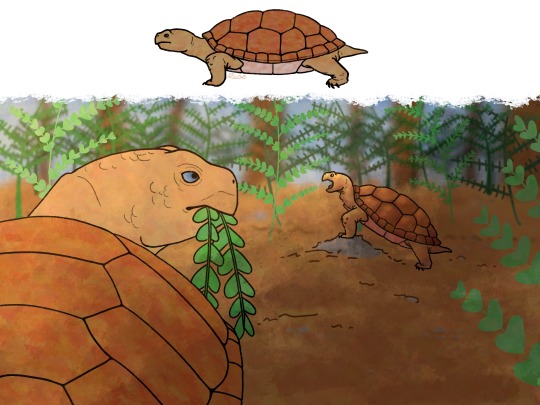
Bashuchelys was a genus of bashuchelyid turtle from the Middle Jurassic. Its type species is B. zigongensis. The other included species is B. youngi. Its known specimens were found in the Sichuan Basin, China. Bashuchelys' known material is made up of many fossils originally assigned to Chengychelys.
"Bashu" means "Bashan," which refers to both the Ba mountain of the Chongqing area and the Shushui river system (also an alternate Chinese name for the Sichuan-Chongqing area). "chelys" is greek for turtle. B. zigongensis, originally assigned to Chengychelys, is named after the nearby town of Zigong, China. B. youngi honors the original discoverer of Chengchelys, C. C. Young.
Its autapomorphies include one pair of mesoplastra that meet at the midline, a hypoplastron-mesoplastron suture that is very close to the pectoroabdominal sulcus, regular and elongate neural series, the fourth vertebral scute is twice as wide as it is long and notably
wider than the third vertebral, a sulcus between the third and fourth vertebrals on the sixth neural, the plastron sutured to the carapace, a fan-shaped bridge with long axillary and inguinal buttresses, a short area of contact between the epiplastra at the midline, the humeropectoral sulcus lying far anterior to the axillary notch, a notably longer pectoral scute than the abdominal, an omega-shaped femoroanal sulcus that extends onto the hypoplastron, a leaf-shaped entoplastron with serrated posterolateral
margins, one pair of intergulars extending deeply onto the endoplastron, and four inframarginals.
Bashuchelys is known from several shell fossils of various completeness. Its family, Bashuchelyidae, is a primitive member of Cryptodira.
Citations: Bashuchelys formal diagnosis; "Chengchelys" baenoides description; "Chengchelys" zigongensis description
Wikipedia article: here
#reptile#reptilia#turtle#paleoart#paleontology#artwork#original art#human artist#bashuchelys#bashuchelyidae#cryptodira#testudines#obscure fossil animals#obscure fossil reptiles#obscure fossil tetrapods
12 notes
·
View notes